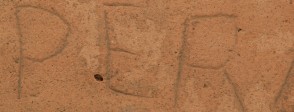The word square itself is an interesting and enjoyable idea to explore as a starting point. The first three activities make a good sequence or could be done individually.
Look at the fragment first. Ask the students what they think the object is made of, whether it is complete and what they think it may be part of. A simple internet search for Roman transport amphoras will bring up lots of examples to explore, including several with trade stamps on the neck or painted labels indicating the contents. Ask the students if they think the lettering was included when the amphora was being made or added later. Ask them to consider what the inscription might say.
Transcribe the letters with the students. Ask them to try to work out what the incomplete letters are. With a little help, you should be able to guide them towards realising that a pattern emerges horizontally and vertically even from the letters that are left. You might choose to explore word squares further before looking in detail at this one. There is a useful link in For the classroom.
Explore the complete word square showing them all the different directions in which the words work and drawing attention to the cross in the centre. Use the animation in For the classroom to show how the letters can be re-arranged and explain the meaning of the Latin phrase and the remaining A and O. Look at the Greek version in the wall painting from Lullingstone in For the classroom. Introduce the students to the idea that it is not Christian at all, but a sort of riddle that may have held some magical meaning for pagans, or simply a clever set of palindromes, and that the Christian possibility was discovered later and not initially intended.
Ask the students to go round the classroom or school and make a list of all the different occurrences of writing they see, noting what the writing is done on. Explore the purpose of the examples they have found. Who are they aimed at? Why? If there are any, identify examples when the writing has been added to something later. Discuss the differences between writing as private and public communication. Compare with the Vindolanda tablet and the Classicianus tombstone in For the classroom.
Look at Regina’s tombstone from A bigger picture and play the interactive game in For the classroom. Use this to start an investigation of different written languages being used at the same time. Why do they think Regina’s husband had two inscriptions carved on her stone? Are there any differences between what is said in the two languages? Make links with any school-based multilingual surveys the students have taken part in.
Have a go at reading some Roman tombstones. Inscriptions on Roman tombstones tend to follow a pattern. Use the leaflet from the Roman Baths Museum in For the classroom to see if they can work out any parts of the tombstones in Object file: Tombstone of a Roman cavalryman. Collect lots of examples of inscriptions from the internet. Ask the students to go through them looking for common occurrences, such as use of the letters D and M at the start, any easy names they may recognise and Roman numerals.
Use the examples in A bigger picture to look at the scripts from which the Roman alphabet developed and the scripts that it replaced in the early medieval period. Do a class survey of languages and how they are written. Are there examples of non-European languages that use the Roman alphabet?
One of these enquiries focuses on a familiar stereotype of the Roman world while the other provides an opportunity for study of a theme over a long period.
Did the Romans really throw the Christians to the lions? Start by discussing what this mysterious square suggests about how safe early Christians felt. Develop this in to a broader enquiry about Roman religion and how it related to other religions – you will find object file: The Roman temple in Bath useful for this. Find out more about how Christians were actually treated. Explain that much of the evidence is from Christian writers and consider their motivation for recording their treatment in this way.
Why do so many people use the Roman alphabet? Start from A bigger picture. Use maps of the Roman Empire to explore how the Roman alphabet spread initially. Discuss how Latin started as a language of conquest and then became one of education and religion with the spread of Christianity. Find out more about runes and Ogam and how they worked. Why might these scripts have given way to the Roman alphabet for writing those languages? Find out how European expansion from the sixteenth century onwards carried European languages and the Roman alphabet across the world. Use the Kiswahili example in A bigger picture to bring the story up to date.


